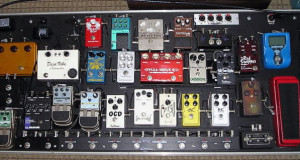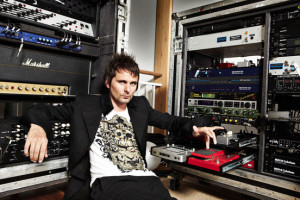Multi-fx vs stompboxes… Multi-effects for lazy guitarists?
Multi-fx vs stompboxes… Are multi-effects for lazy guitarists? I recently posted on Facebook the open question: “What is your opinion on stompboxes versus multi-fx devices?”. Opinions were divided, about 50/50, and everyone was equally right. My personal experience says that multi-fx’s are for lazy musicians! But hey, before you guys start throwing mud… let me tell you a little story!
When I started playing electric guitar as a pants guy, it didn’t take long for my first stompbox to become a fact… at the time I bought a discarded Electro Harmonix Step Stone Flanger from a friend in the atheneum, for 10 German Marks. I still have this pedal by the way, and in the meantime this is worth a small fortune as a collector’s item! But hey Baustein, don’t deviate now! OK, not much later I bought another second-hand pedal, an Ibanez Distortion that had a life of its own and only wanted to turn on/off when it had the desire, then a Morley Wah-Fuzz with rust stains and missing screws, a Boss Chorus that had optically survived a heavy war, etc.

And sure enough, as a teenager I was proud and happy as a pig with my pedal set-up! A great experience to be able to experiment like crazy with the order and settings of effects. Great fun that sound building, but very time-consuming. But honestly, in the athenaeum you don’t have a ball to do and a sea of free time, do you? So I had time during my teenage years to mess around with effects! When I started performing more and more after my higher music studies and gradually evolved towards a professional musician, I ended up in a second phase where I sold most of the stompboxes and bought a top-of-the-bill multi-fx device from Lexicon. A device of approx. 2000 euros! Not that much money you would think?
Hey I’m talking about 2000 euros about 16 years ago – that was a small fortune at the time! Heaven on earth that device. Plugging in guitar, choosing the right preset, and I sounded like my greatest guitar heroes without any effort. As I became an increasingly experienced musician, I entered a third phase. Haha, you can indeed guess it. I was sick of it, spitzat! The multi-fx device flew into the closet and I started buying high quality stompboxes again. Back to the basics, and after all, that’s the way I like it (aha aha)! Why? And what are the pros and cons of stompboxes and multi-effects?
High-quality stompboxes have a warmer sound, but cost much more money compared to multi-fx devices. But you can work much more personally by combining different pedals from different brands. Each combination and every other sequence creates new dimensions and other possibilities for your own sound building. Do I put the Overdrive in front of or behind the Wah? Do I put the Compression in front of or behind the Overdrive? The sky is the limit! That way you can work very creatively and form your own sound. Moreover, you get to know the different effects by trying to imitate sounds, for example you learn how the EQ, delay, gain, reverb etc etc should stand to imitate certain guitarists. Stompboxes also have the advantage that the sales value is relatively stable, and with older pedals the value can even increase! What is the biggest disadvantage? It is extremely time consuming and often messing with many cables, adapters, struggling with bad contacts and you need to know something about effects.

Multi-fx devices, what’s up with that? If you see a guitarist with, for example, an Axe-FX-II, then you have 3 options : 1. he’s a wannabe guitarist with a lot of money, 2. it’s an amateur who has no idea how effects work at all and then buys an Axe-FX-II like everyone else, 3. He is a professional guitarist who knows what he is doing and knows how and when to be lazy. Unfortunately, the first 2 groups dominate the music scene. But bon. Just a word of explanation about my experience. A multi-fx is perfect for today’s society: everything must go fast, it should not take too much effort, quantity and purchase price take precedence over quality. Multi-FXs are usually an approximation of the analog, sometimes up to 99% but just not.
But on the other hand, so blissfully easy to use! Do you need a preset a la Santana – connect usb cable and download Santana preset and hopla you sound like our good old Carlos! Jimi Hendrix? Download, click and hey even find different presets of it! It is a huge advantage and convenience when, for example, you play in a cover band with a varied program. Then a multi-fx is without a doubt the best option. Messing around with stompboxes on stage to go from a Metallica song to an Elvis Presley, and then surfing from Avicii to Kings of Leon? This is a pure waste of time and it is a total failure in terms of stage presence! I’d rather see a guitarist running across the stage than a guitarist who’s constantly turning the knobs of his pedals like a madman!
Also in terms of setup you need less space, you don’t have to drag with a heavy pedal case, no messing with bad contacts or one broken cable (and which one is the broken of the 25 patch cables … sigh!), And on top of that, the soundcheck is done faster. What is one of the major disadvantages? Multi-fx devices are one-size-fits-all! If I buy effect device X and so do you, we both sound the same. Switching or adjusting effects in a multi-fx is possible with some programming, but you still fish in the same pond. There is little creativity possible and you can’t just throw another pedal from another brand in between.
Another example: I recently heard someone talk about guitarist X of cover band Y: “An incredible top guitarist! What a sound! When they play a song by Faith No More, his guitar sounds just like the original! If he plays U2, it sounds just like The Edge!” I was doubly lying for a moment when I saw in the photo that he simply played with pre-nibbled presets of an Axe-FX-II … Faith No more? OK just download preset. U2? Ah here’s the preset, USB cable plugs, tick and done… uh The Edge! Do I have a problem with that? No, not at all. The audience doesn’t care about that anyway, and the guitarist himself probably doesn’t either. If you can bring the songs in the right atmosphere, in the right context and with the right sound, that’s what really counts at the end of the ride. But when, especially with own and original songs, you want to be different from others … Then the train stops there. Ask all those guitarists with their multi-fx’s about the covers they play, how, for example, the sound of The Edge is actually constructed?

The vast majority have heard with difficulty of a delay, EQ, compression, limiter, gate, etc etc. A compressor? That’s to inflate the tires of my car! A gate? That’s at the airport hey! Maybe he/she doesn’t even care, and I respect that. But I just think it’s a shame that many of those multi-fx owners don’t have a clue about what they’re actually doing. Terrifying, because sound building is just an extra dimension of playing music and is great fun! Am I now against those multi-fx devices? Not at all, I use them myself occasionally. You have to put it all in context.
If I bring original songs with their own sound, you will only see stompboxes or possibly a multi-FX in the circuit for some extra reverb or delay. If I am on stage with a varied cover band, I will usually play with a multi-fx because as a professional musician I 1. don’t have the time to spend whole days looking for sounds, 2. it has to be fast in terms of setup and sound check, 3. because the average audience doesn’t even hear the difference between digital or analog so WTF, 4. Because I don’t want to be on stage all the time, fiddling with those buttons. Last but not least, another disadvantage of multi-fx devices is the resale value. These devices are actually computers that after a few years have no more residual value than old iron … uh old plastic with a circuit board.
Conclusion : it is definitely not black and white! Decide for yourself what you need, and how far your interests extend. But also, take the best of both worlds!
Stompboxes pro:
– Higher sales value
– better and warmer sound
– own sound building
– creativity is much greater, the sky is the limit
– combining different types and brands possible
– very educational
– really something for audiophiles
– quality and indestructible
– you get a faulty pedal on stage from the circuit, and the show goes on
Stompboxes contra:
– good pedals are very expensive
– cumbersome and time-consuming
– often leads to unnecessary waste of time on stages
– many circuits and patch cables give more chance of defects or malfunctions
– a long circuit can cause noise and humming
– Stompboxes can best be connected to a guitar amplifier
Multi-FX pro:
– quickly assembled and soundchecked
– ideal for “lazy” guitarists
– preset sounds quick and easy to download
– cheaper than a range of quality stomp boxes
– ideal for cover bands
– perfect for guitarists who attach less importance or have no interest in sound building
– easy to quickly jam or compose
– the better multi-fx devices can be connected directly to the PA via DI
Multi-FX contra:
– low residual value after a few years
– quickly dated
– one-size-fits-all
– just a digital approach to …
– own soundbuilding rather limited
– je leert weinig over de werking van effecten
– in case of a defect on the stage … is really everything defective

